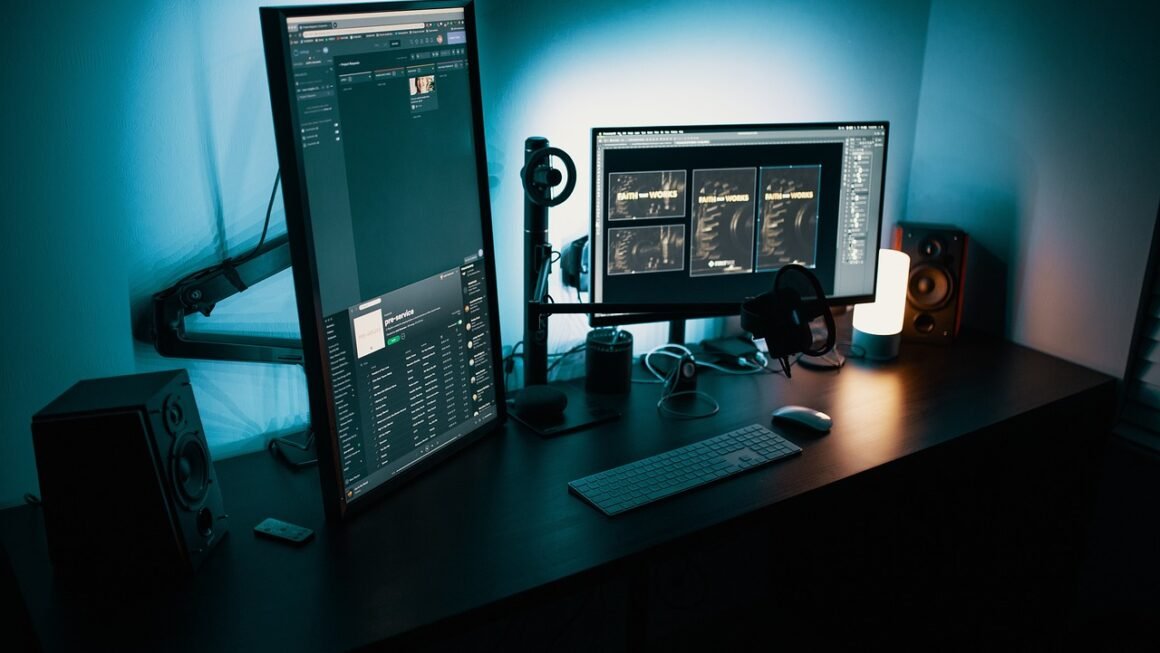Imagine pointing your smartphone at a blank wall and instantly seeing a virtual bookshelf, complete with your favorite titles neatly arranged. Or, picture trying on a new pair of glasses virtually, using your phone’s camera to overlay different frames onto your face before you even set foot in a store. This is the power of Augmented Reality (AR), a technology that’s rapidly transforming how we interact with the world around us. This blog post will dive deep into augmented reality, exploring its capabilities, applications, and future potential.
What is Augmented Reality?
Defining Augmented Reality
Augmented reality (AR) is an interactive experience of a real-world environment where the objects that reside in the real world are enhanced by computer-generated perceptual information, sometimes across multiple sensory modalities, including visual, auditory, haptic, somatosensory and olfactory. AR alters one’s ongoing perception of a real-world environment, whereas virtual reality completely replaces the user’s real-world environment with a simulated one. In essence, AR blends digital elements with the physical world.
How AR Works
AR typically works by using a device, such as a smartphone, tablet, or dedicated AR headset, to detect the user’s environment. This is often achieved through:
- Camera Tracking: The device’s camera captures images of the real world, and computer vision algorithms analyze these images to identify specific markers, objects, or features.
- Sensors: Accelerometers, gyroscopes, and other sensors help the device understand its orientation and movement in space.
- GPS and Location Services: These technologies pinpoint the user’s location, allowing AR applications to overlay geographically relevant information onto the real world.
Once the environment is understood, the AR software can overlay digital content, such as images, videos, 3D models, or text, onto the user’s view of the real world. This overlaid content appears to be seamlessly integrated with the physical environment.
Benefits of Augmented Reality
Enhanced User Experience
AR significantly enhances the user experience by providing interactive and engaging ways to access information and interact with products and services. Examples include:
- Interactive Product Previews: Allowing customers to visualize furniture in their homes before purchasing.
- Educational Games: Engaging students in learning through interactive simulations and experiences.
- Improved Navigation: Overlaying directions onto the real world, making it easier to find your way.
Increased Engagement and Interaction
AR fosters deeper engagement and interaction by making experiences more immersive and personalized. This leads to:
- Higher Customer Satisfaction: Customers are more likely to be satisfied with their purchases when they can visualize and interact with products before buying.
- Increased Brand Loyalty: Engaging AR experiences create a stronger connection between customers and brands.
- Improved Learning Outcomes: Students learn more effectively when they are actively engaged in the learning process.
Improved Efficiency and Productivity
AR can improve efficiency and productivity across various industries by providing workers with real-time information and guidance. Consider:
- Manufacturing: Providing assembly instructions directly on the machinery being worked on.
- Healthcare: Assisting surgeons with real-time information during operations.
- Logistics: Optimizing warehouse operations by overlaying information on packages and shelves.
Cost Savings
While initial setup can have a cost, AR ultimately leads to cost savings by:
- Reducing Training Costs: AR-based training simulations can be more cost-effective than traditional methods.
- Lowering Maintenance Costs: Remote experts can use AR to guide technicians through complex repairs, reducing the need for on-site visits.
- Minimizing Errors: AR can help workers avoid costly errors by providing real-time guidance and feedback.
Applications of Augmented Reality
Retail and E-commerce
The retail sector is a hotbed for AR innovation. Here’s how it’s being used:
- Virtual Try-On: Customers can virtually try on clothes, makeup, and accessories before making a purchase.
- Product Visualization: Allowing customers to see how furniture or appliances would look in their homes. IKEA Place is a great example of this.
- Interactive Product Information: Scanning product packaging with a smartphone to access additional information, videos, and reviews.
Education and Training
AR is revolutionizing education and training by creating immersive and engaging learning experiences. Consider these examples:
- Interactive Textbooks: Bringing textbook content to life with 3D models and animations.
- Simulated Environments: Allowing students to explore historical sites or scientific concepts in a virtual environment.
- Hands-on Training: Providing workers with realistic simulations for practicing complex tasks.
Healthcare
AR is transforming healthcare by improving patient care, training medical professionals, and enhancing surgical procedures. Practical applications include:
- Surgical Assistance: Overlaying patient data onto the surgeon’s view during operations.
- Patient Education: Visualizing medical conditions and treatments for patients.
- Rehabilitation: Providing patients with interactive exercises for physical therapy.
Manufacturing and Engineering
AR offers significant benefits for manufacturing and engineering, including:
- Assembly Guidance: Overlaying step-by-step instructions onto the assembly line.
- Remote Assistance: Connecting field technicians with remote experts for troubleshooting and repairs.
- Quality Control: Using AR to identify defects and ensure product quality.
Developing AR Applications
AR Development Tools
Several tools and platforms are available for developing AR applications, including:
- ARKit (Apple): A powerful AR development platform for iOS devices.
- ARCore (Google): Google’s platform for building AR experiences on Android devices.
- Vuforia: A popular cross-platform AR SDK that supports a wide range of devices and platforms.
- Unity: A versatile game engine that can be used to create both AR and VR experiences.
Key Considerations for AR Development
When developing AR applications, it’s important to consider the following factors:
- User Experience: Design intuitive and user-friendly interfaces that are easy to navigate.
- Performance: Optimize the application for performance to ensure smooth and responsive experiences.
- Accuracy: Ensure that the AR content is accurately aligned with the real-world environment.
- Privacy: Protect user privacy by being transparent about data collection practices.
Future Trends in AR Development
The future of AR development is likely to be shaped by the following trends:
- Improved AR Hardware: More powerful and affordable AR headsets will become available.
- Advanced Computer Vision: AI and machine learning will enhance the accuracy and capabilities of AR applications.
- 5G Connectivity: Faster and more reliable connectivity will enable more immersive and seamless AR experiences.
- Cloud-Based AR: Cloud computing will provide the processing power and storage needed for complex AR applications.
Conclusion
Augmented Reality is more than just a futuristic concept; it’s a tangible technology transforming industries and enhancing everyday experiences. From retail and education to healthcare and manufacturing, AR is proving its value by increasing engagement, improving efficiency, and offering cost-effective solutions. As AR technology continues to evolve and become more accessible, we can expect to see even more innovative and impactful applications in the years to come. Embracing AR is no longer just a possibility, but a necessity for businesses and individuals looking to stay ahead in an increasingly digital world.



